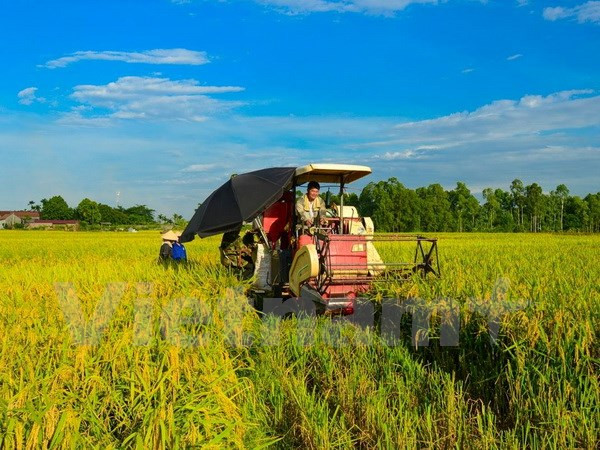 Vietnam will reform rice production to gain sustainable development in the production and export of rice (Photo: VNA)
Vietnam will reform rice production to gain sustainable development in the production and export of rice (Photo: VNA)Hanoi (VNA) - Vietnam will reform rice production to gainsustainable development in the production and export of rice, according to Vietnam’sRice Market Development Strategy from 2017 to 2020.
Accordingto the strategy for developing the country’s rice export market in the2017–20 period with a vision to 2030, oneof the goals is to gradually reduce the rice export volume but increase thevalue of exported rice.
Specifically,the annual rice export volume is expected to reach about 4.5-5 million tonnesin 2020, earning an average of about 2.2-2.3 billion USD per year.
From2021 to 2030, the nation’s annual rice export volume is expected to reach about4 million tonnes, earning 2.3 to 2.5 billion USD per year. At the same time, itwould restructure rice export products.
Exportsof fragrant rice, specialty rice and Japonicarice will account for the largest proportion of the total volume ofexported rice at 40 percent, followed by glutinous rice and whiterice exports at 25 percent each.
Meanwhile, theproportion of high quality, high-value, organic, highly-nutritious rice andproducts made from rice will be about 10 percent.
TranCong Thang, deputy director of the Institute of Policy andStrategy for Agriculture and Rural Development under the Ministry ofAgriculture and Rural Development, said that at present Vietnam does nothave a national plan for the development of export rice but provinces havedeveloped areas of producing high-quality rice products while applying hightechnology for production. In addition, the nation has had geographicalindicators for rice products such as Hai Hau rice and Dien Bien rice.
Meanwhile,many local brands have been protected including Kinh Mon glutinous ricein Hai Duong province, Dong Trieu glutinous rice in Quang Ninh province andaromatic rice of Soc Trang province. Many enterprises havedeveloped brands for their business and for their rice products.
Meetingthe market demand, in recent years, the area of growing high-qualityrice is increasing. Rice exporters are also more active in seeking ways topenetrate high-quality rice markets as well as linking with each other to buildthe rice production chain. Especially, in the Mekong Delta, there are 10 to 12brands of rice produced by private enterprises such as Ngoc Troi and Ngoc Dong.
However,Thang said, besides development of high-quality rice, Vietnam still needsto develop rice products in traditional rice markets and expand the exportmarket to Africa.
Inaddition, Vietnam and many other countries producing rice are experiencingvarious problems such as salinity intrusion and climate change, so riceproduction to adapt to climate change is a big challenge, he said.
TheMARD has worked with the International Rice Research Institute (IRRI) todevelop key rice varieties for each region according to the market demand.
Deputy Minister of Agriculture and Rural Development Le QuocDoanh said that to implement the restructuring of the rice production industryin Vietnam, the agricultural sector has to improve rice varieties, productiontechnique and infrastructure; set up appropriate mechanisation in production,preservation and processing; and promote production chain. The sector willidentify suitable rice varieties for each export market.
Hesaid that initially, the sector would focus on researching high-quality ricevarieties and rice production technical package to reduce production cost,improve rice quality, protecting the environment and ensure sustainableagricultural reforms.
Toimplement Vietnam’s Rice Market Development Strategy for the period 2017 to2020, the MARD will review and identify rice growing areas with an advantage toadjust production plans and convert areas with inefficient riceproduction to other purposes. It will plan a schedule on adjusting productionscale and output to meet domestic and international demand and the competitiveability of Vietnamese rice.
Itwill also plan and organise production based on regions of material and regionsspecialising in the production of rice, demand of specific export markets, andorders of enterprises.
Theministry said that in the first seven months of the year, Vietnam exported3.3 million tonnes of rice, earning 1.5 billion USD, up 15.7 percent in volumeand 13.7 percent in value compared to the January-July period of2016. China was still the largest export market for Vietnamese rice,followed by the Philippines.-VNA




























